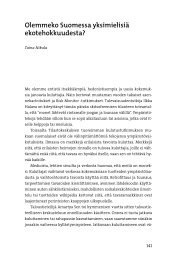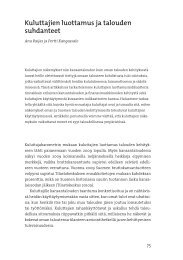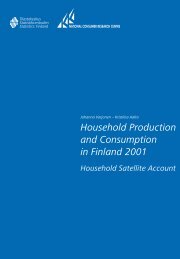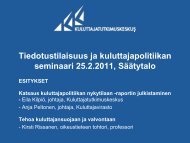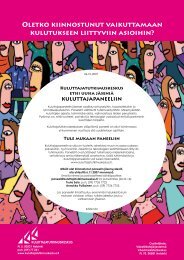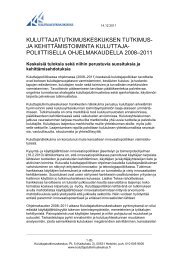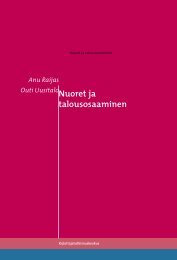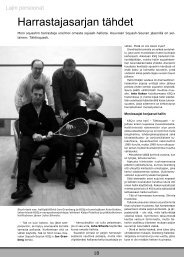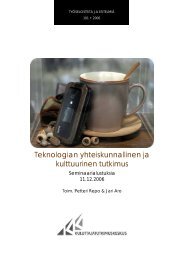Household Production and Consumption in Finland 2001
Household Production and Consumption in Finland 2001
Household Production and Consumption in Finland 2001
Create successful ePaper yourself
Turn your PDF publications into a flip-book with our unique Google optimized e-Paper software.
Data from the National Accounts<br />
National accounts figures were used <strong>in</strong> several different ways. Items from the<br />
core national accounts, such as hous<strong>in</strong>g services produced by owner-occupiers<br />
<strong>and</strong> own-account house construction, were drawn directly from the accounts<br />
(SNA hous<strong>in</strong>g). The same method was used for agricultural produce produced<br />
for own use, hunt<strong>in</strong>g, fish<strong>in</strong>g <strong>and</strong> pick<strong>in</strong>g wild berries <strong>and</strong> mushrooms (SNA<br />
food). These figures for the whole country were broken down between<br />
different types of households us<strong>in</strong>g the correspond<strong>in</strong>g proportions from the<br />
<strong>Household</strong> Budget Survey.<br />
Figures on household consumption were another key source of<br />
<strong>in</strong>formation. In order to produce figures for different types of households, it<br />
was necessary first of all to comb<strong>in</strong>e <strong>Household</strong> Budget Survey <strong>and</strong> national<br />
accounts statistics. As a general rule, data on consumption levels were drawn<br />
from the national accounts, while detailed breakdowns by consumption<br />
category were obta<strong>in</strong>ed from the <strong>Household</strong> Budget Survey. Thirdly, national<br />
accounts figures were used <strong>in</strong> order to produce figures on household capital<br />
<strong>and</strong> to calculate taxes <strong>and</strong> subsidies on production.<br />
4.2 Compilation ofproduction <strong>and</strong> generation<br />
of<strong>in</strong>come account<br />
Determ<strong>in</strong><strong>in</strong>g the value oflabour<br />
In the <strong>in</strong>put approach, the amount of labour is usually based on the amount of<br />
time spent <strong>in</strong> work. The data here have been obta<strong>in</strong>ed from Statistics F<strong>in</strong>l<strong>and</strong>’s<br />
Time Use Survey <strong>in</strong> 1999–2000. Only time spent <strong>in</strong> primary activities is<br />
<strong>in</strong>cluded. It has been suggested that time spent <strong>in</strong> secondary activities should<br />
also be <strong>in</strong>cluded because their exclusion greatly underestimates the total<br />
volume of labour (e.g. Floro & Miles 2003). As long as they are excluded,<br />
much of the work that is done particularly <strong>in</strong> the care of children <strong>and</strong> the frail<br />
elderly will cont<strong>in</strong>ue to be ignored. If, however, secondary activities were to be<br />
<strong>in</strong>cluded, a decision would be needed on how to weight these activities. Does,<br />
for <strong>in</strong>stance, keep<strong>in</strong>g an eye on children simultaneously with some other<br />
activity carry the same value as full-time childcare? Furthermore, if a monetary<br />
value were given to a secondary activity, should the share of that activity be<br />
deducted from the value of the primary activity? If this were the case, the<br />
calculations should be exp<strong>and</strong>ed to cover all other activities as well, s<strong>in</strong>ce the<br />
primary activity may consist of unpaid work <strong>and</strong> a secondary activity may be a<br />
leisure or personal activity <strong>and</strong> vice versa. There is no general agreement on<br />
these issues this far. Therefore the amount of time for primary activities has<br />
been <strong>in</strong>cluded <strong>in</strong> its entirety <strong>in</strong> the <strong>Household</strong> Satellite Account.<br />
Critics po<strong>in</strong>t out that time use reveals noth<strong>in</strong>g about either the efficiency of<br />
production or the quality of the output. In the literature there is some<br />
discussion about how the volume of labour is <strong>in</strong>fluenced by whether people<br />
enjoy the work they are do<strong>in</strong>g, or how the amount of time at one’s disposal<br />
18 Statistics F<strong>in</strong>l<strong>and</strong> National Consumer Research Centre




